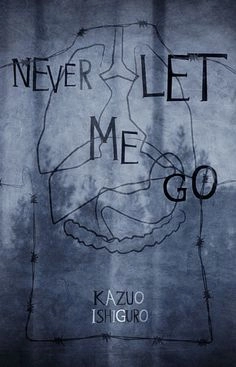Never Let Me Go by Kazuo Ishiguro is a poignant novel that explores themes of identity, friendship, and mortality in a dystopian world where human clones are created for organ donation.

Never Let Me Go (novel) Background
British author Kazuo Ishiguro, who was born in Japan, wrote the book “Never Let Me Go,” which was released in 2005.
In the other past depicted in the book, people cloned themselves with the intention of giving their organs. The plot centers on Kathy, Tommy, and Ruth, three friends who attended the clone boarding school in Hailsham as children.
When they grow up and learn the reality of their mission, they have to accept their destiny.
Title Of Never Let Me Go
The tune “Never Let Me Go” is the source of the title, which Kathy hears on a cassette tape while she is a resident of Hailsham. The song has special meaning for Kathy, Tommy, and Ruth.
It also serves as a recurring theme in the book, symbolizing their need for companionship and will to stay together in the face of their dismal future.

Main Characters
| Character | Description |
|---|---|
| Kathy H. | The protagonist and narrator. Reflective and introspective, she tries to make sense of her life as a clone. |
| Tommy D. | Kathy’s close friend. Kind-hearted but somewhat naïve, he struggles with his emotions and sense of identity. |
| Ruth | Another friend from Hailsham. Manipulative and self-centered, she often makes decisions that hurt others. |
Summary Of Never Let Me Go
In this novel, readers are transported on a moving journey through the lives of three friends—Tommy, Ruth, and Kathy—who all grew up at Hailsham, a boarding school with a hidden past.
Moreover, the dystopian world of the novel, where human clones are manufactured for organ donation, addresses issues of friendship, identity, and fate’s inevitable course.
Kathy tells the tale, reflecting on her time at Hailsham and her close relationships with Tommy and Ruth. As they get older, they learn the truth about why they are here and the harsh reality that lies ahead.
They hold onto their recollections of Hailsham and their relationships in spite of this understanding, looking for purpose and connection in a world that sees them as disposable.
Exploring the meaning of what it means to be human is one of the novel’s most interesting features. Ruth, Tommy, and Kathy are clones, but they have the same wants and feelings as everyone else.
Their yearning for affection, camaraderie, and direction underscores the enduring facets of the human journey.

In addition, readers are drawn into a vivid and eerie world by Ishiguro’s deft use of language and imagery from the very first page.
His writing is expressive and poetic, reflecting the characters’ lives’ joys and sorrows in equal measure.
Ishiguro encourages readers to identify with Kathy, Tommy, and Ruth through his writing and experience their pleasures and sorrows as though they were their own.
Important moral and ethical problems are also raised in the book. The ethical quandaries surrounding the harvesting and cloning of organs center on the worth of human life and the boundaries of scientific experimentation with it.
Ishiguro’s narratives encourage readers to think critically about these problems and the ramifications of scientific discoveries.
The exquisitely crafted book “Never Let Me Go” lingers in the minds of readers long after they close the cover. Furthermore, it is a tale of friendship and treachery, love and loss, and ultimately, the human spirit’s ability to persevere in the face of difficulty.
For everyone who wants to delve into the depths of the human experience, Ishiguro’s novel is a must-read because of his brilliant storytelling and insightful observations.

Analysis Of Never Let Me Go
Kazuo Ishiguro’s book “Never Let Me Go” explores the intricacies of human life by fusing science fiction aspects with challenging philosophical issues.
Furthermore, readers are encouraged to consider issues of identity, mortality, and the morality of scientific advancement as they set off on this fictional adventure.
The story of the book revolves around Kathy, Tommy, and Ruth, three friends who attend the mysterious boarding school Hailsham together as children.
Readers follow the characters’ journey from childhood innocence to the harsh realities of maturity through Ishiguro’s excellent narrative.
They negotiate the complexities of their relationships with one another and the outside world as they struggle with the realization that they are clones made for the purpose of organ donation.
One of the primary themes tackled in “Never Let Me Go” is the question of what it means to be human. Ruth, Tommy, and Kathy are clones, but they have the same wants and feelings as everyone else.
They build close ties with each other, seek love and friendship, and finally confront their mortality with a mix of fear and acceptance.
In addition, readers are prompted to reconsider their preconceived beliefs regarding identity and the essence of existence by Ishiguro’s depiction of their humanity.

In addition, Ishiguro’s writing style gives the book an additional layer of depth. His writing is graceful and expressive, bringing readers into the characters’ lives and engrossing them in their experiences.
Ishiguro carefully crafts a vivid and compelling story by combining words and visuals. The narrative also poses significant moral issues regarding the boundaries of scientific advancement.
Furthermore, the novel’s depictions of organ harvesting and cloning make readers consider the moral ramifications of utilizing technology to prolong human life at the expense of other people.
Ishiguro invites readers to reflect on the ethical conundrums that civilization faces as it continues to push the limits of scientific discovery through his nuanced treatment of these intricate themes.
To sum up, this is a book that provides a thorough examination of the human condition. Moreover, it pushes readers to reevaluate their conception of what it means to be human through its investigation of identity, mortality, and ethics.
Ishiguro’s brilliant narrative and provocative issues turn this book into a timeless masterpiece that has lasting appeal.

Themes Of Never Let Me Go
| Theme | Description |
|---|---|
| Identity | The novel explores the characters’ struggle to define themselves and their place in the world, despite being clones created for organ donation. |
| Friendship | The bonds of friendship between Kathy, Tommy, and Ruth are central to the story, highlighting the importance of human connection and companionship. |
| Mortality | The characters’ awareness of their fate as organ donors forces them to confront their mortality and consider what it means to live a meaningful life. |
| Ethics | The novel raises ethical questions about the treatment of clones and the use of science to prolong human life, prompting readers to consider the moral implications of technology. |
| Memory | Memories play a significant role in the characters’ lives, shaping their identities and influencing their decisions as they navigate their past and present experiences. |
| Acceptance | Ultimately, the characters must come to terms with their fate and find a sense of acceptance, highlighting the resilience of the human spirit in the face of adversity. |
Conclusion
In conclusion, “Never Let Me Go” is a haunting and thought-provoking novel that challenges readers to reconsider the nature of humanity and the ethical implications of scientific progress.
FAQs
Never Let Me Go is about the lives of three friends who grow up in a boarding school and later discover they are clones bred for organ donation.
The point of “Never Let Me Go” is to provoke thought on the ethics of human cloning, the nature of humanity, and the inevitability of mortality.
Never Let Me Go is worth reading for its profound exploration of identity, friendship, and the human condition in a haunting dystopian setting.
Yes, there is a subtle love triangle in “Never Let Me Go” between the main characters, Kathy, Tommy, and Ruth, adding depth to their relationships and emotions.
Related Posts:
11 Important Themes Of Pygmalion & Symbolism| By Bernard Shaw
Oswald In King Lear | Character Analysis & Quotes
Analysis Of First Player’s Speech In Hamlet | By Shakespeare
Character Analysis Of Romeo And Juliet | By Shakespeare
King Lear By William Shakespeare | Summary, Analysis & Themes


